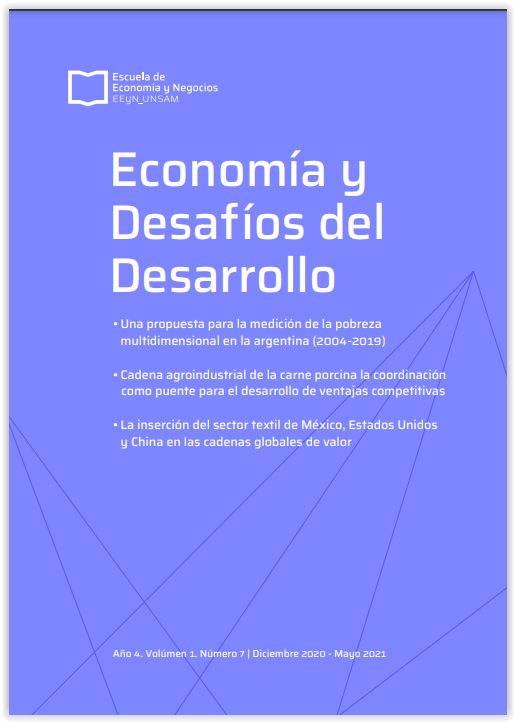Pork agroindustrial sector coordination as a bridge for the development of competitive advantages
Keywords:
competitiveness, agribusiness, innovation, technology, performanceAbstract
The purpose of this work was to study the performance of the Argentine pork agroindustrial chain to identify the potential and the limitations to the development of the activity in the country and its insertion abroad. For this, the study was delimited from a map of the chain. Then, a sectoral diagnosis was made through the development of the Porter Diamond and, within this, the relationship between two of its edges was addressed: The conditions of the factors and the conditions of the demand, based on the study of the relationship between the increase in production and 3 explanatory variables (consumption, exports and% of lean) between 2009 and 2019. The results showed a growth in activity in recent years in technical and commercial aspects (higher conversion efficiency, improvements in the quality of cattle, increase in domestic demand and exports). However, it is observed that this improvement in the performance of the agroindustrial chain is limited to a reduced number of productive and industrial units, which account for 84% of the work, with a high technological level and innovative forms of coordination. The simple linear regression model showed a high correlation between production and the 3 variables studied. There is a great space for the construction of competitive advantages whose development will require innovation in the organizational designs of the actors, especially those of smaller scale.
References
Anders, S., Moser, A. (2010). Consumer choice and health: The importance of health attributes for retail meat demand in Canada. Canadian Journal of Agricultural Economics, 58 (2), pp. 249-271.
Boehjje, M y Doering, O. (2000). Farm Policy in an Industrialized Agriculture. Journal of Agribusiness, Vol 18 (1), Special Issue, March 2000: 53-60.
Bolsa de Comercio de Rosario (BCR). (2018). Radiografía de la producción de cerdos en Argentina. Dirección de Informaciones y Estudios Económicos. Informativo Semana.
Caleman, S. 2009. Falhas de coordenação em sistemas agroindustriais complexos: uma aplicação no sag da carne bovina. Tesis doctoral. Pp.140Principio del formulario.
Di Rienzo J.A., Casanoves F., Balzarini M.G., Gonzalez L., Tablada M., Robledo C.W. InfoStat versión 2020. Centro de Transferencia InfoStat, FCA, Universidad Nacional de Córdoba, Argentina. URL http://www.infostat.com.ar
Dulce, E. 2012. Lechería ovina en la Argentina: identificación y análisis de los puntos de conflicto en las transacciones productor - industria e industria - distribución y su impacto sobre la sostenibilidad del negocio en Argentina. Tesis de Maestría.
Dulce, E.; Bircher, D.; Negri, R. 2018. Sector Agroindustrial y Exportación. Metodología para la selección de mercados estratégicos. XLIX Reunión Anual de AAEA “Hacia una mayor competitividad del sector Agroindustrial” Libro de resúmenes. FCE. UNL. Pag. 46.
Han, J.; Lu, J.; Trienekens, J.; Omta, S. (2013), The impact of supply chain integration on firm performance in the pork processing industry in China. Chinese Management Studies Volume 7, Issue 2, 2013, Pages 230-252.
Iglesias, D; Ghezan, G. (2013). Análisis de la Cadena de la Carne Porcina en Argentina. Estudios Socioeconómicos de los Sistemas Agroalimentarios y Agroindustriales. INTA. ISSN 1852:4605. 175 páginas.
Kherallah, M. & Kirsten, J. (2001). “The New Institutional Economics. Application for Agricultural Policy Research in Developing Countries.” Markets and Structural Studies Division. International Food Policy Research Institute (http://www.ifpri.org). USA.
Lamprinopoulou, C. Y Tregear, A. (2006). Agrifood SMEs in Greece: the role of collective action. British Food Journal. Vol. 108 No. 8, 2006. pp. 663-676.
Ministerio de Agricultura, Ganadería y Pesca. (2020). “Anuario 2019 Porcinos”.
North, D. (1991). Institutions, Institutional Change and Economic Performance. Cambridge University Press.
Oh, S. & See, M.T. (2012). Pork preference for consumer in China, Japan adn South Korea. Asian-Australasian Journal of Animal Sciences. Volume 25. Pag. 143-150.
Peri, G. 2011. Estrategias de priorización de exportaciones: un análisis de experiencias exitosas. Programa “Apoyo a los procesos de apertura e integración al comercio internacional”. ATN/ME-9565-RG BID-FOMIN. 174 Págs.
Porter, M. E. (1985). Competitive Advantage: Creating and Sustaining Superior Performance. Free Press, New York, 1985. Chapter 1.
Porter, M. E. (1990). The Competitive Advantage of Nations. Free Press, New York, 1990 & 1998.
Porter, M. E. (1991). The Competitive Advantage of the Inner America's Green Strategy. Scientific American Apr. 1991.
Resurreccion, A. (2004). Sensory aspects of consumer choices for meat and meat products. Meat Science, 66 (1), pp. 11-20.
Schnettler, B., Fica, D., Sepúlveda, N., Sepúlveda, J., Denegri, M. (2010). Valuation of intrinsic and extrinsic attributes on the purchase of beef in southern Chile. Revista Cientifica de la Facultad de Ciencias Veterinarias de la Universidad del Zulia, 20 (1), pp. 101-109.
Cardin, R. (2019). Informes de Cadenas de Valor. Carne Porcina. Julio 2019. Subsecretaría de Programación Microeconómica. ISSN 2525-0221.
Williamson, O. (2000). The new institutional economics: Taking stocks, looking ahead. Journal of Economics Literature. Vol. XXXVIII pp. 595-613. 2000.
Williamson, O. E. (1991). “Comparative Economic Organization: The Analysis of Discrete Structural Alternatives.” Administrative Science Quarterly, 36: 269–296.
Zylbersztajn, D. (1996). Governance structures and agribusiness coordination: A transaction costs economics based approach. Research in Domestic and International Agribusiness Management. Editor Ray Goldberg. Graduate School of Business Administration. Harvard University. Vol. 12. 1996.



